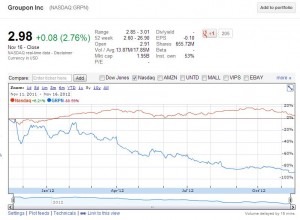Groupon (GRPN) recently released its Q3 results where they missed their sales target and posting a net loss of almost $3 million. GRPN’s share price fell 25% bringing it down 80% below its original initial public offering (IPO) value, they are also eliminating 80 sales jobs.
This begs the question, how much longer will Groupon survive and is their business model sustainable?
GRPN was founded in 2008 by Andrew Mason and was once named by Forbes magazine as the “fastest growing company ever”. GRPN is essentially a mass email marketing company that positions itself as win-win-win for retailers, customers and itself.
In 2010, Google offered GPRN $6 billion, however the firm declined, instead seeking to do its own IPO in 2011, which raised $700 million (valuing the company at $12.7 billion). At the time, this made GRPN the largest IPO by an internet company since Google.
Criticism of the business model have been raised for the following issues:
Attracts the wrong types of customers:
- GRPN segments for price-sensitive customers and these customers are unlikely to be long-term customers.
Impacts operational logistics:
- GRPN deals typically expire within a certain period. This can have significant impact on the logistics of a firm. For example, if a hair dressing salon with a limited number of chairs does a GRPN promotion, the business has a constrained number of chairs from which to serve customers. This means that it may lose those seats to lower paying customers who are unlikely to come again. This presents itself a as a challenge for firms who are looking to provide excellent customer service.
Alienates your current customer base:
- Small businesses are built on personal relationships. Groupon’s hidden cost may jeopardize your existing customer base as you are providing a deal to new customers instead of rewarding your long standing customers.
So what does this mean for small businesses?
1. Before you embark on a GRPN – develop a marketing strategy. What is the marketing problem you are facing, where do opportunities exist and what type of customer are you trying to reach. This will help you to clarify and understand what type of customer you are trying to attract and whether GRPN would appeal to that group.
2. If relevant, incorporate GRPN into your marketing strategy, however don’t limit yourself to that area exclusively. Small businesses tend to consider GRPN as a silver bullet that is an easy way to generate new leads. Businesses need to consider what financial, strategic and logistical impact this promotion may have on your firm.
3. Do your homework. Consult with other business who have used GRPN as a marketing techniques. There may be some lessons that you can learn from other’s experiences.
4. If you have an existing loyal customers consider investing your marketing dollars in them (e.g. recession discount). Focus in retention that increasing the number of people through the door.
Overall, GRPN can be an effective marketing tool, however it needs to be approached cautiously and with a clear understanding of what its purpose is and what businesses need to consider when incorporating it as part of their marketing strategy.

